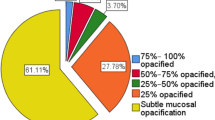Abstract
Acute invasive fungal rhinosinusitis (AIFRS) is a fulminant disease with a high mortality rate. Here, we review the clinical and pathologic features of AIFRS over a 30-year period at a tertiary-care academic center focusing on diagnostic practice, especially the use of intra-operative consultation (IOC). A 1-year trial of intraoperative staining with DiffQuik® (DQ) was also assessed. There were 202 cases from 104 patients with AIFRS. The incidence of AIFRS increased over time (6.8 per year in the past decade versus 1.9 before 2009) as did the number of IOCs per case (2.4 per case in the past decade versus 0.6 before 2009). Disagreement between final diagnosis and IOC was seen in 8.3 % of patients, and the block-by-block error rate was 14.9 %. Fusarium was the most common fungus identified. An attempt to categorize the fungal organism based on histopathology was performed in 85.6 % of patients, with 91 % agreement with microbial cultures or PCR. Fungal hyphae were subjectively easier to identify on DQ stained cryostat sections compared to on routine hematoxylin and eosin stained sections and hyphae were identified in all 5 blocks in which organisms were present. The increasing incidence of AIFRS and expanding use of IOC indicate a need to improve and standardize the diagnostic protocol. The use of DQ as visual aid in IOC for AIFRS may be useful.





Similar content being viewed by others
References
Webb BJ, Ferraro JP, Rea S, Kaufusi S, Goodman BE, Spalding J. Epidemiology and clinical features of invasive fungal infection in a US Health Care Network. Open Forum Infect Dis. 2018;5(8):ofy187. https://doi.org/10.1093/ofid/ofy187.
Soler Z, Schlosser R. The role of fungi in diseases of the nose and sinuses. Am J Rhinol Allergy. 2012;26(5):351–8. https://doi.org/10.2500/ajra.2012.26.3807.
Thompson LDR, Wenig BM, Muller S, Nelson B. Section 1: nasal cavity and paranasal sinuses. Diagnostic pathology: head and neck. 2nd ed. Salt Lake City: UT Elsevier; 2016.
Waitzman AA, Birt BD. Fungal sinusitis. J Otolaryngol. 1994;23:244–9.
Fung M, Babik J, Humphreys IM, Davis GE. Diagnosis and treatment of acute invasive fungal sinusitis in cancer and transplant patients. Curr Infect Dis Rep. 2019;21(12):53.
Thomas J, Walsh MN, Gamaletsou MR, McGinnis Randall T, Hayden DP, Kontoyiannis,. Early clinical and laboratory diagnosis of invasive pulmonary, extrapulmonary, and disseminated mucormycosis (zygomycosis). Clin Infect Dis. 2012;54(suppl_1):S55–60. https://doi.org/10.1093/cid/cir868.
Parikh SL, Venkatraman G, DelGaudio JM. Invasive fungal sinusitis: a 15-year review from a single institution. Am J Rhinol. 2004;18(2):75–81.
Gillespie MB, O’Malley BW Jr., Francis HW. An approach to fulminant invasive fungal rhinosinusitis in the immunocompromised host. Arch Otolaryngol Head Neck Surg. 1998;124(5):520–6. https://doi.org/10.1001/archotol.124.5.520.
Chamilos G, Marom EM, Lewis RE, Lionakis MS, Kontoyiannis DP. Predictors of pulmonary zygomycosis versus invasive pulmonary aspergillosis in patients with cancer. Clin Infect Dis. 2005;41:60–6.
Orlowski HLP, McWilliams S, Mellnick VM, et al. Imaging spectrum of invasive fungal and fungal-like infections. Radiographics. 2017;37(4):1119–34. https://doi.org/10.1148/rg.2017160110.
Wandell GM, Miller C, Rathor A, et al. A multi-institutional review of outcomes in biopsy-proven acute invasive fungal sinusitis. Int Forum Allergy Rhinol. 2018;8(12):1459–68. https://doi.org/10.1002/alr.22172.
Ghadiali MT, Deckard NA, Farooq U, Astor F, Robinson P, Casiano RR. Frozen-section biopsy analysis for acute invasive fungal rhinosinusitis. Otolaryngol Head Neck Surg. 2007;136(5):714–9. https://doi.org/10.1016/j.otohns.2007.01.002.
Papagiannopoulos P, Lin DM, Al-Khudari S, et al. Utility of intraoperative frozen sections in surgical decision making for acute invasive fungal rhinosinusitis. Int Forum Allergy Rhinol. 2017;7(5):502–7. https://doi.org/10.1002/alr.21918.
Vallabhaneni S, Benedict K, Derado G, Mody RK. Trends in hospitalizations related to invasive aspergillosis and mucormycosis in the United States, 2000–2013. Open Forum Infect Dis. 2017;4(1):ofw268. https://doi.org/10.1093/ofid/ofw268.
Roxbury CR, Smith DF, Higgins TS, Lee SE, Gallia GL, Ishii M, Lane AP, Reh DD. Complete surgical resection and short-term survival in acute invasive fungal rhinosinusitis. Am J Rhinol Allergy. 2017;31(2):109–16. https://doi.org/10.2500/ajra.2017.31.4420.
Hennessy M, McGinn J, White B, Payne S, Warrick JI, Crist H. Frozen section as a rapid and accurate method for diagnosing acute invasive fungal rhinosinusitis. Otolaryngol Head Neck Surg. 2018;159(3):576–80. https://doi.org/10.1177/0194599818770615.
Crist H, Hennessy M, Hodos J, et al. Acute invasive fungal rhinosinusitis: frozen section histomorphology and diagnosis with PAS stain. Head Neck Pathol. 2019;13(3):318–26. https://doi.org/10.1007/s12105-018-0965-8.
Schuman TA, Nguyen JH, Yelverton JC, Almenara JA, Powers CN. The sensitivity and specificity of touch preparation for rapid diagnosis of invasive fungal sinusitis: a pilot study. Ear Nose Throat J. 2018;97(1–2):E32–6. https://doi.org/10.1177/0145561318097001-208.
Acknowledgements
The authors would like to thank Melvin Stuart, Senior Clinical Laboratory Technologist, for his help with frozen sections and development of the DiffQuik frozen section protocol.
Author information
Authors and Affiliations
Corresponding author
Ethics declarations
Conflict of interest
The authors declare that they have no conflict of interest to disclose.
Ethical Approval
Ethical approval and consent were waived by the Ethics Committee of the Washington University in Saint Louis Institutional Review Board, in view of the retrospective nature of the study and all the procedures being performed were part of the routine care.
Additional information
Publisher’s Note
Springer Nature remains neutral with regard to jurisdictional claims in published maps and institutional affiliations.
Supplementary Information
Below is the link to the electronic supplementary material.
Rights and permissions
About this article
Cite this article
Gonzalez, M.L., Chen, S., Mazaheri, P. et al. Acute Invasive Fungal Sinusitis: A 30-Year Review of Pathology Practice and Possible Utility of the DiffQuik® Stain. Head and Neck Pathol 15, 852–858 (2021). https://doi.org/10.1007/s12105-021-01295-8
Received:
Accepted:
Published:
Issue Date:
DOI: https://doi.org/10.1007/s12105-021-01295-8




